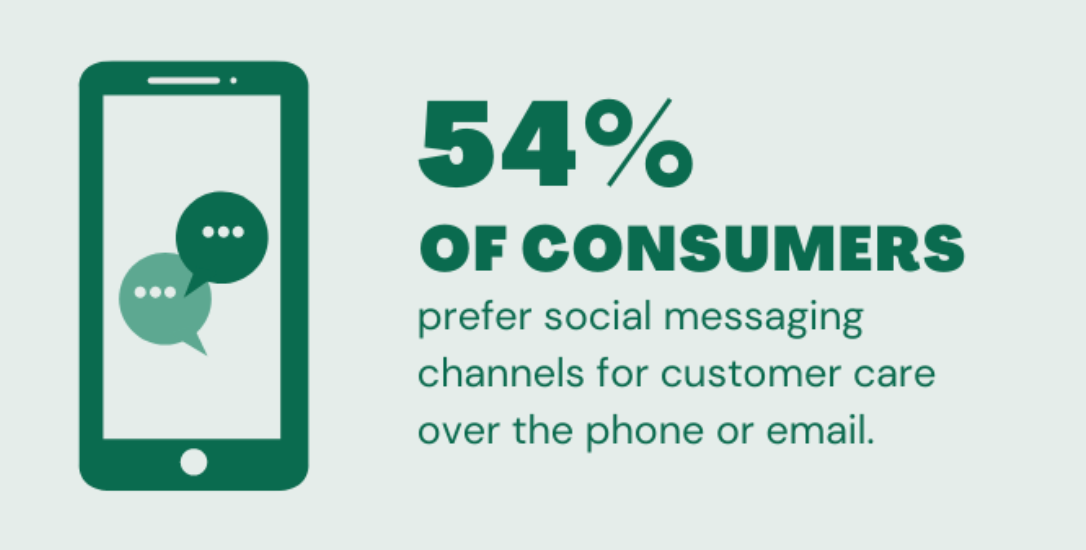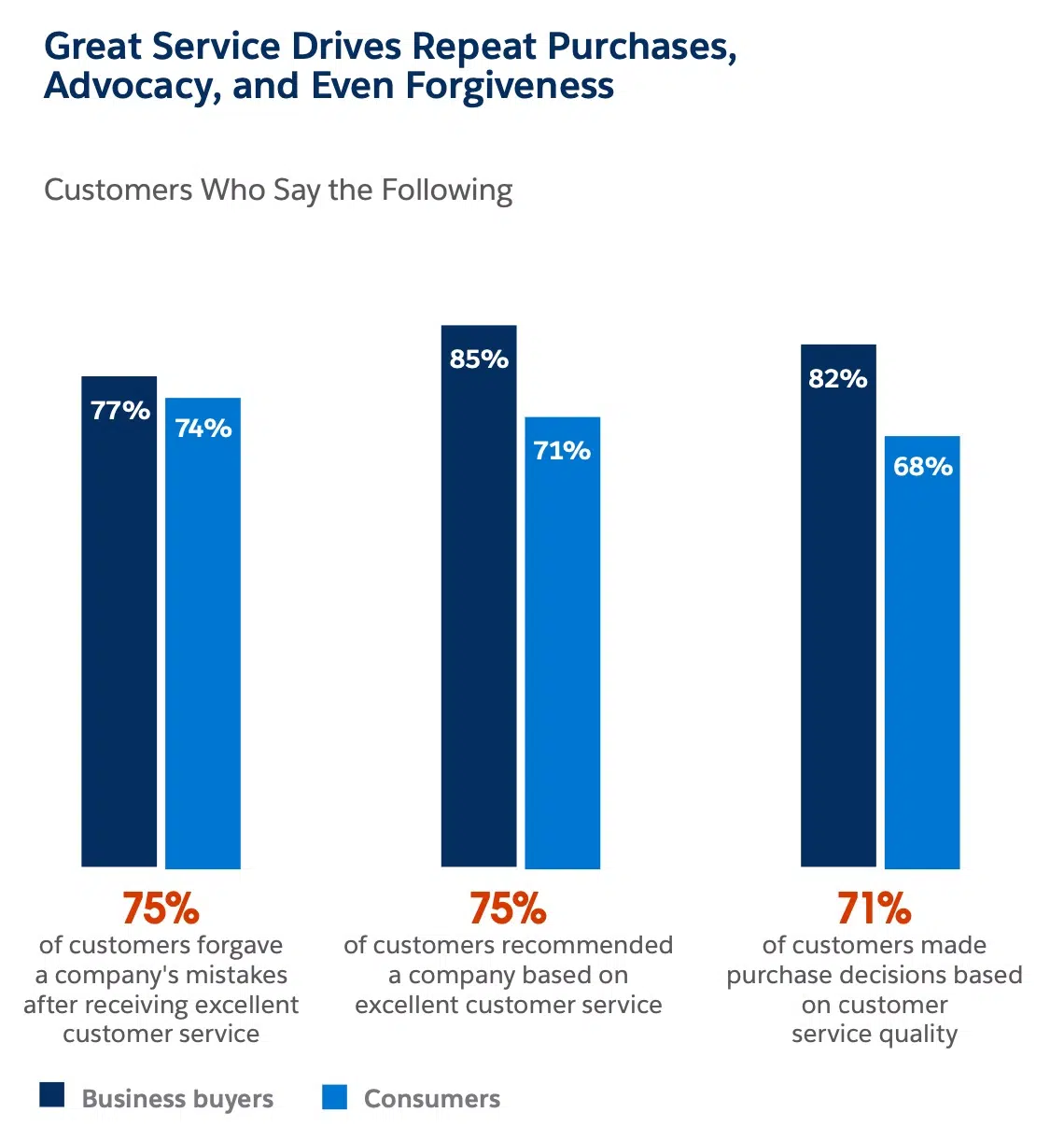Imagine this: you order a pizza delivery from your local store. It’s your favorite, and when you’re ready to sink your teeth into it… you realize there’s a slice missing.
Upset, you upload a photo to X with proof of the crime and complain about the store’s poor service. Just when you’re about to decide you’ll never shop there again, the store’s official account replies and, in addition to inviting you to contact the store, tells you your next order will be at a 30% discount.
Was your day saved? Maybe, maybe not, but anyone would rather have an answer than nothing at all when this happens, and this is one of the most important points of customer service: taking care of people’s problems with your product or service.
With the advent of the Internet and social networks, customer service has been digitized to become one of the fundamental pillars of any company when it comes to engaging its public and answering their possible doubts and inconveniences with your product. This is how we arrive at social media customer service, which plays a crucial role in meeting and exceeding customer expectations and fostering customer engagement.
What is social media customer service?
Social media customer service refers to the attention and support that companies provide to their customers through digital platforms. This includes answering questions, resolving problems, handling complaints and maintaining active communication with users.
Instead of being limited to traditional channels such as telephone or email, social media customer service takes advantage of the immediacy and visibility offered by the networks to interact with customers in a closer way. Effective management of customer service interactions on these platforms can lead to improved response times, customer satisfaction, and overall service quality. Additionally, effective social media customer service can lead to increased brand loyalty.
Social media customer service is a fundamental part of any company’s digital presence. Through platforms such as Facebook, Twitter, Instagram and LinkedIn, brands can resolve doubts, address complaints and build solid relationships with their audience.
According to HelpLama data, 54% of customers prefer social messaging channels to emails or calls. In other words, the customer service paradigm is shifting to a more digital field, and brands know it.
Choosing the Right Social Media Channels
Selecting the right social media channels for customer service is essential to providing timely, effective support. With numerous platforms available, it’s easy to feel overwhelmed about where to focus your efforts. The key is to align your channel selection with where your customers are most active and engaged. Customer feedback and platform-specific engagement are two powerful indicators for determining the best channels for your support strategy.
Here are some tips to help you choose:
- Identify where your audience spends time: Are your customers mostly on Instagram, Facebook, or Twitter? Focus on the channels where they’re already active.
- Consider platform strengths: Facebook offers private messaging, while Twitter excels at fast, public responses. Choose based on what aligns best with your service goals.
- Track engagement and feedback: Evaluate customer interactions across platforms to see where they feel heard and supported.
By carefully choosing your channels, you’ll ensure that customers can reach you easily and that your team can respond in a timely, impactful manner.
Setting Up Social Media Customer Care
Setting up effective social media customer care is essential to meeting your customers’ needs with speed and precision. A strategic approach will help you build trust and foster customer loyalty. Minimizing response time is a top priority for ensuring satisfaction and building credibility. Follow these steps to set up a robust social media customer care system:
- Choose the right tools: Select social media management software that integrates well with your customer support system. Look for tools that support message tracking, automated responses, and performance analytics.
- Define clear response guidelines: Establish response time goals and tone guidelines to ensure consistency. Aim for immediate responses to inquiries, especially for time-sensitive issues.
- Train your team: Equip your customer support team with the skills they need to handle inquiries professionally and efficiently on social media.
- Monitor conversations regularly: Use social listening tools to monitor customer sentiment and identify issues as they arise.
- Analyze and optimize: Regularly review performance metrics like response time, resolution rates, and customer feedback to refine your approach.
By setting up an organized, responsive social media customer care system, you’ll ensure that customer support is timely, impactful, and aligned with your brand values.
Integration with Other Customer Service Channels
Integrating social media customer service with other customer service channels is crucial for providing a seamless and omnichannel experience for customers. Imagine a customer reaching out to your brand on Twitter, then following up via email, and finally calling your support line. Without a unified system, this could lead to duplicate responses, missed inquiries, and a fragmented customer experience.
By using a unified customer service platform, your customer service reps can manage customer inquiries across multiple channels, including social media, email, phone, and live chat. This integration ensures that every interaction is tracked and managed efficiently, leading to improved response times and higher customer satisfaction.
Some popular tools for integrating social media customer service with other channels include:
Customer relationship management (CRM) software: Centralizes customer data and interactions, making it easier to provide personalized support.
Helpdesk software: Streamlines ticket management and ensures no customer inquiry falls through the cracks.
Omnichannel customer service platforms: Offers a holistic view of customer interactions across all channels.
Social media management tools: Helps monitor and respond to social media posts and direct messages efficiently.
By integrating these tools, businesses can provide a consistent customer experience, reduce the risk of duplicate responses, and enhance overall customer satisfaction and loyalty.
Essential tools for social media customer support
To keep up with your online community, manage customer inquiries, and be able to answer all their questions in the best possible way, it’s critical to have some of the following tools in your toolbox. These tools can significantly enhance the customer experience by streamlining interactions and providing timely responses.
Before we continue, we remind you Sotrender can help you have a clearer vision of your digital presence, your strengths and opportunities for improvement so you can optimize and become even better. With our customer service audit, we have no doubt your strategies and actions will have a greater impact wherever you want to impact.
Now, let’s move on!
Social listening tools
These allow you to track brand mentions, customer queries, comments, and direct messages across all social networks. They’re perfect to understand what kind of reactions and impressions your brand generates online to generate insights for better strategies.
Chatbots and automation
Chatbots can automatically respond to frequent queries, freeing up time for human agents to focus on more complex cases.
Often, they’re integrated into brand websites, answering basic queries from people or registering their data so that a person can attend to them if the situation is more complex.
Customer relationship management (CRM)
Serves as a general database of the information you provide to customers. It helps a lot to discover and understand possible patterns of behavior, whether individual or collective.
They also offer important support when integrating with other tools and platforms to automate processes.
Collaboration tools
These platforms allow you to work together with several teams of the same company to streamline work processes between departments. They also allow you to upload documents, calendars, as well as important information for different tasks.
Several tools fit here, from appointment scheduling apps for small businesses, video calling apps, communication and task management platforms, and so on.
Forms
Forms are ways to collect interesting information from the people who follow your brand and to build a database that you can store for later. It also helps to collect doubts, questions and common queries to establish patterns.
Benefits of social media customer service for brands
There is no doubt social media customer care offers incredible benefits to the brands that bet on it, significantly enhancing customer satisfaction. If you remember the example of pizza, you’ll realize that it has the ability to save a very painful situation and, depending on the specific case, turn it into a real success story.
Additionally, effective social media customer service can lead to increased customer retention.
Generate a positive reputation
One of the most important benefits of social media customer service is the drive to create a positive brand image.
Your customers will feel satisfied with you if your customer service team deals effectively with their doubts or queries, which will encourage them to speak well of you among their friends, colleagues and family.
These people may be curious about your brand, which will lead them to try your products and services and recommend you if they have a good customer experience (CX). This creates a continuous cycle of good opinions and impressions for your brand.
Customer loyalty and satisfaction are reinforced
According to Sprout Social’s 2023 Data, 63% of customers feel their loyalty to a brand is strongly influenced by the quality of customer service they receive on social media.
Those who get a good experience with your customer service will have more reasons to keep choosing you over your competitors. As the saying goes, don’t fix what isn’t broken.
That being the case, it’s very important to ensure customers receive top-notch customer care on any of the social media channels they use, be it X, Facebook, Instagram, LinkedIn, or other. Skilled customer service reps play a crucial role in providing timely and effective solutions to customers’ queries, enhancing their overall experience.
If you guarantee your customers’ satisfaction, comfort and happiness, you’ll strengthen their loyalty to you, and they’ll feel more engaged with what you offer. In other words, you’ll increase retention.
Increase revenue
It’s clear one of the main benefits of customer service on social media is its way of boosting revenue in your project by enhancing customer service performance. There are several reasons for this.
For one thing, the customers you already have will stick with you and recommend you to their friends and family, who can become your future customers if they find in you what they need. In a 2020 study shared by SquareTalk, 92% of people responded that their friends and family tended to be their most trusted source of information when they want to inquire about a brand.
On the other hand, attending people’s cases on the Internet generates visibility for your project, which will allow you to reach new audiences and markets you may not have considered in your initial strategy.
Less problems with your clients
It’s crystal clear that offering exceptional customer service will prevent people from having problems with your brand and getting a bad impression of it, which, among other things, will lead them to decide to cut off their relationship with you.
In social networks, other users’ problems with your service or product can dissuade other people from trusting you, especially if it’s someone with a lot of visibility.
Training and Development for Social Media Teams
Providing ongoing training and development for your social media teams is essential to ensure they have the skills and knowledge needed to deliver excellent social media customer service. Social media platforms are constantly evolving, and so are customer expectations. Therefore, continuous learning is key.
Training should cover various aspects, including:
Social media platforms and their features: Understanding the nuances of different social media channels like Facebook, Twitter, and Instagram.
Customer service skills and best practices: Effective communication, empathy, and problem-solving skills.
Brand voice and tone: Ensuring consistency in how your brand communicates across all social media channels.
Crisis management and conflict resolution: Handling negative feedback and crises professionally.
Analytics and reporting tools: Using data to measure and improve customer service performance.
Popular training methods include:
Online courses and webinars: Flexible and accessible learning options.
In-person training sessions: Hands-on training for more interactive learning.
Workshops and conferences: Opportunities to learn from industry experts and network with peers.
Mentorship programs: Pairing less experienced team members with seasoned professionals.
On-the-job training: Learning through real-world customer service interactions.
Investing in training and development not only enhances your team’s skills but also boosts their confidence and effectiveness in providing top-notch social media customer support.
Measuring Social Media Customer Service Success
Tracking your social media customer service success isn’t just about numbers; it’s about understanding the true impact of your efforts. Key performance indicators (KPIs) are essential to gauge the effectiveness of your approach and pinpoint where improvements can be made. Some crucial metrics to consider include:
- Response time: How quickly are you responding to customer inquiries?
- Resolution rate: Are issues being resolved in the first interaction?
- Customer satisfaction: Are your customers happy with the support they’re receiving?
Use these metrics to refine your strategy, keep customers happy, and build loyalty.
Crisis Management and Social Media Customer Service
Handling a crisis on social media requires a swift and strategic response. The way you manage crisis communication can either strengthen your brand’s reputation or damage it. To handle social media crises effectively, consider these essential tips:
- Stay calm and respond quickly: Delay only worsens the issue. Timely responses can help contain the situation.
- Address the issue transparently: Acknowledge the problem, explain steps being taken, and communicate openly.
- Monitor sentiment continuously: Keep track of conversations around the issue and respond to key concerns.
Having a proactive crisis management plan in place is crucial for ensuring your brand can navigate social media challenges with ease.
Legal and Ethical Considerations
When providing social media customer service, it’s crucial to navigate the legal and ethical landscape carefully. Compliance with data protection and privacy laws, intellectual property laws, and consumer protection laws is non-negotiable. Additionally, ethical considerations such as transparency, honesty, and respect for customer privacy are paramount.
Key legal and ethical considerations include:
Data protection and privacy laws: Ensuring customer data is handled securely and in compliance with regulations like GDPR.
Intellectual property laws: Respecting copyright and trademark laws in your social media content.
Defamation and libel laws: Avoiding statements that could harm someone’s reputation.
Consumer protection laws: Providing accurate information and fair treatment to customers.
Accessibility laws: Ensuring your social media content is accessible to all users, including those with disabilities.
Ethical considerations involve:
Transparency and honesty: Being upfront about your policies and practices.
Respect for customer privacy and data: Protecting customer information and using it responsibly.
Fairness and consistency: Treating all customers equally and fairly.
Responsiveness and timeliness: Addressing customer inquiries promptly and effectively.
Staying updated on legal and ethical issues can be achieved through resources such as:
Industry associations and trade organizations: Providing guidelines and best practices.
Government websites and regulatory agencies: Offering official information and updates.
Social media platforms’ terms of service and community guidelines: Ensuring compliance with platform-specific rules.
Online courses and training programs: Keeping your team informed about the latest legal and ethical standards.
Industry blogs and publications: Staying current with trends and developments.
By adhering to these legal and ethical standards, businesses can build trust with their customers and maintain a positive reputation in the realm of social media customer service.
Social media customer service in action: 3 case studies
All talk, let’s get down to action. There’s no better way to understand what social media customer service is all about than by watching brands put it to the test in real time through a dedicated customer support channel. In these case studies, the role of the customer support team is crucial in addressing and resolving customer issues effectively.
Hyundai USA
No one trusts a product or service with many negative reviews, especially when paying for it represents one of the highest expenses you can make. So it is with cars.
Hyundai USA knows this, hence its dedication to responding to negative online reviews and offering adequate support channels to users so they can quickly resolve their problems. As long as such problems are resolved, the brand’s reputation is maintained, and the impact of negative comments on potential customers can be minimized.

Hyundai is committed to a formal tone with the user and where attention and care to detail are paramount.
Spotify
Although not as expensive as a car (probably), the streaming services we use on a daily basis also have a cost, and users have the right to demand a service according to what they pay for. Let’s take a look at how Spotify serves its users on social media.
As with many other brands, Spotify has a separate account for its social media customer service. With it, in addition to answering users’ questions, Spotify also takes the chance to answer general questions and make product announcements.

Unlike Hyundai USA, Spotify’s communication style is more informal and user-friendly, but without being careless.
Wendy’s
No one likes to pay for a meal that is poorly made, spoiled, or did not meet their expectations. Food complaints are some of the most common customer service complaints, and one that can cost the brand dearly.
Talking about Wendy’s, the brand’s approach is to offer help to people in a short but direct and friendly manner. The vast majority of the time, the account asks users to share necessary information via DM so that customer service can notify the location near the user.

Unlike Spotify, Wendy’s doesn’t have a separate account on X dedicated to customer service, but rather handles each case from the main account, which is dedicated not only to resolving issues, but also to creating humorous content.
Best practices for social customer service strategy in social networks
By now you’ve probably realized that providing customer service on social media is much more than answering questions and handling complaints. It’s about building, maintaining and strengthening relationships with people, as well as boosting brand awareness on social media. Additionally, understanding and utilizing customer service metrics is crucial for evaluating the effectiveness of your social customer service strategies.
To do this, there are 4 best practices that will help you get the most out of your social media service channels:
Quick responses
Today, customers expect fast and effective responses to their queries. Take the test, if you had a problem with the headphones you ordered through Amazon, wouldn’t you like to have a quick response from the seller and find a solution as soon as possible?
We aren’t the only ones to say so. According to a Super Office survey, fast response times are the most important attribute for users when evaluating a brand’s CX. The percentage of users who said this? 75%.
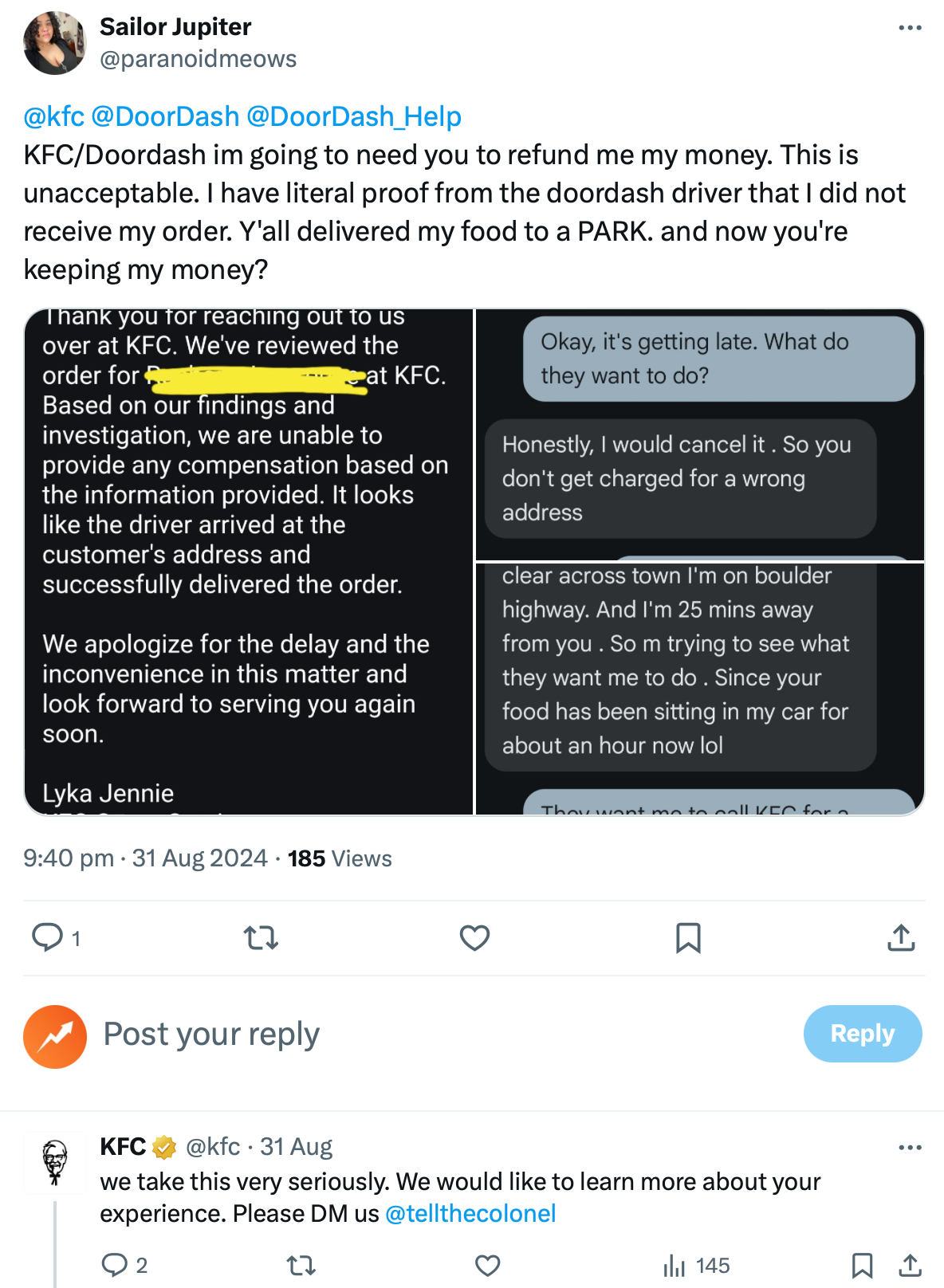
In this example from KFC, the franchise’s official X account responded just 4 minutes after the original tweet. While you can’t always react that quickly, the idea is to be aware of the mentions you receive on social media so that you can address them promptly.
As a brand, your duty is to set consistent deadlines and expectations of response to your audience. Just as you can’t, or shouldn’t, answer them many hours after they communicate with you about an issue, it’s also unrealistic for them to expect you to respond the second they write the message.
Personalized interactions
It’s true templates speed up response times a lot, but don’t forget to add the person’s name and other details that build a genuine and authentic message.
Nowadays, personalization is non-negotiable if you want to succeed. People don’t want to be treated as numbers or simple revenue generators, but as individuals with real problems and feelings who want to be addressed and recognized as such.
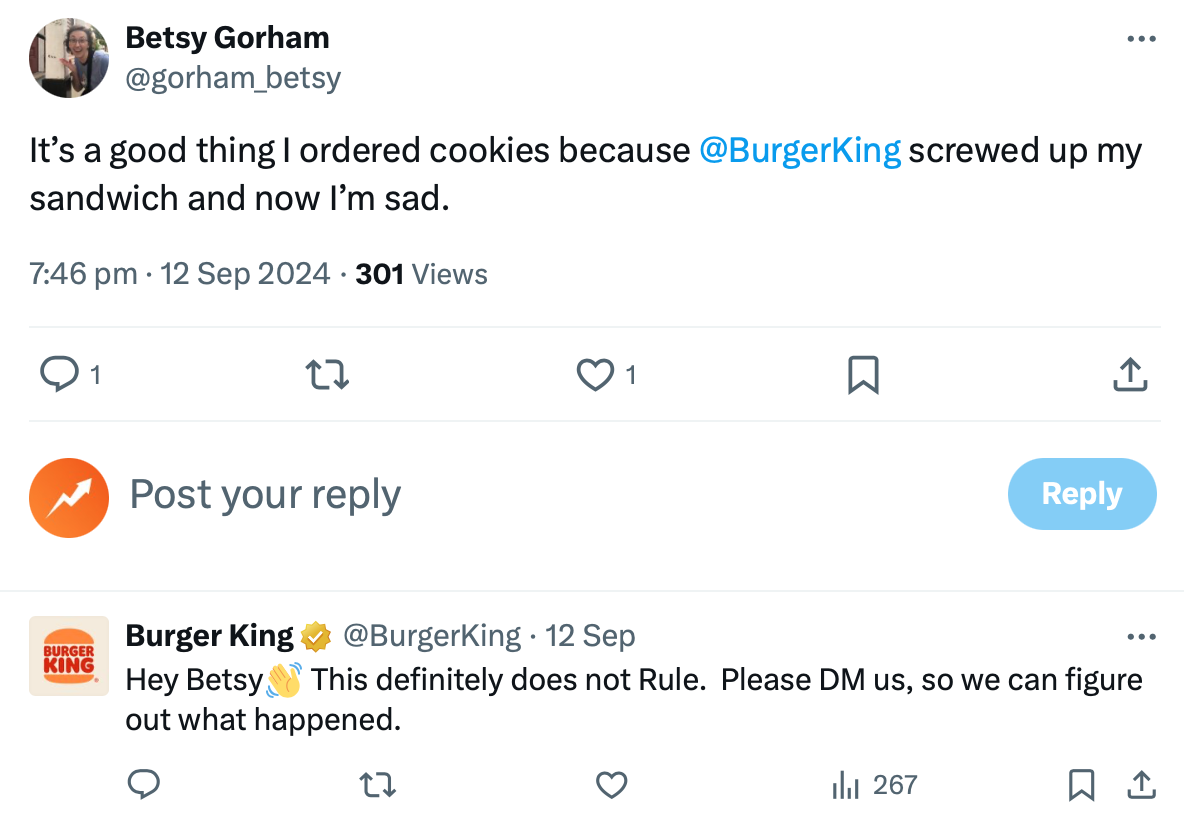
Here, Burger King greets the customer by name before channeling their inquiry. It’s a short, effective message that also starts by offering a more person-friendly approach.
According to Sprout Social, 70% of customers expect a company to provide personalized responses to their customer service inquiries. When you personalize an interaction with a customer, you are fostering an emotional connection that will stick in their mind for much longer.
Monitor and act proactively
Actively listen and monitor different social media. Look for specific keywords, trends or mentions of your brand to find out what’s being talked about.
This is how you’ll reach people outside of direct inquiries they have with you. You can join conversations, offer solutions, or simply show your appreciation for positive mentions.
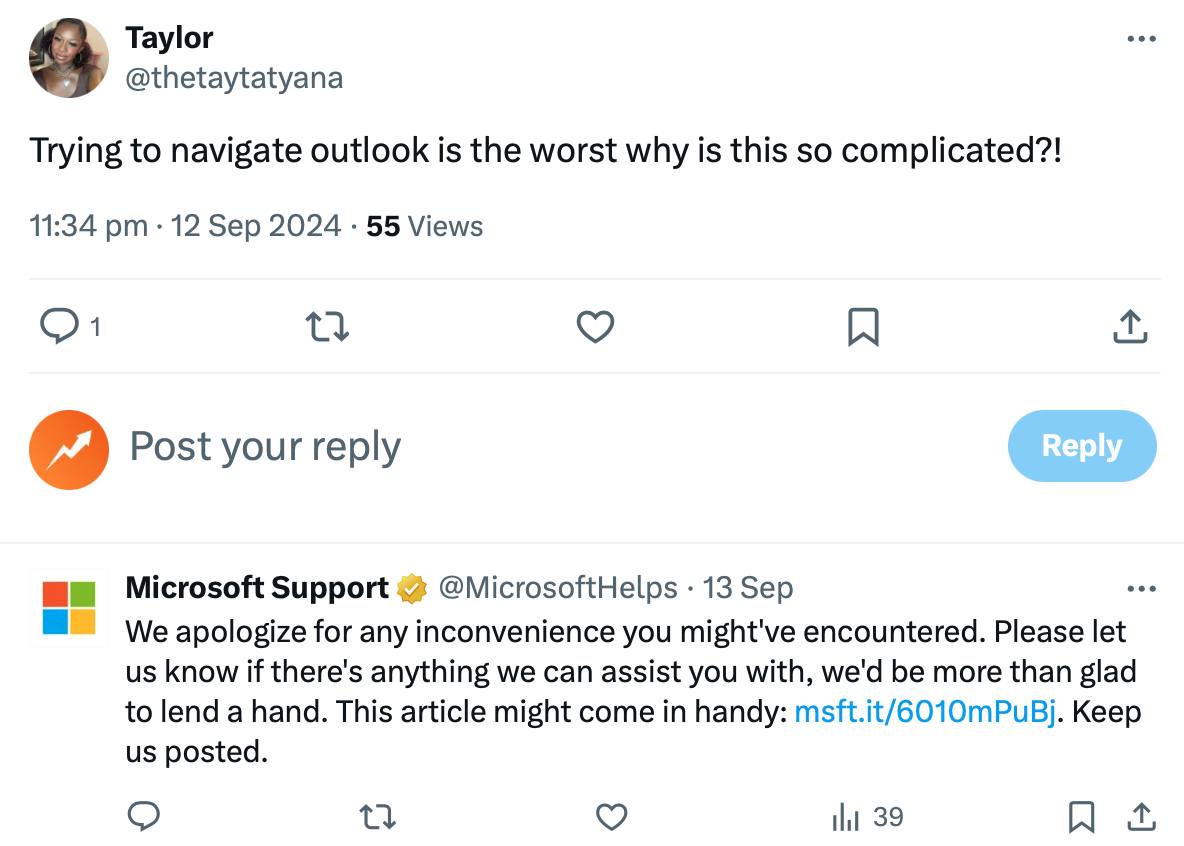
In this example, Microsoft customer service handles a person’s complaint about Outlook, its email service. Notice how the original message doesn’t mention the account at any point, and yet Microsoft reaches out to the user to channel their concern, most likely by continuous monitoring of X beyond mentions.
Gather feedback
Use social media to gather feedback about your products, services, and the experience people have with you as a brand. Along with this, actively search feedback through forms, surveys or direct questions.
Of course, the information you collect won’t be of much use if you don’t design and execute concrete actions to improve your customers’ experience.

In this example, Apple’s support account on X asks a customer to expand a little more on the malfunction of one of its products. It’s a chance for the company to further explore a potential Apple Watch malfunction thanks to the experience of one of its customers.
The Future of Social Media Customer Service
The future of social media customer service is exciting, with new technologies and trends emerging all the time. Artificial intelligence is set to play a significant role in enhancing customer interactions and automating responses. Here are some trends to watch out for:
Final tips
You already have almost everything we wanted to give you from the beginning, but the most important thing is missing: some final tips to help you integrate all this in a coherent and orderly manner, including providing customer support through social media channels. Utilizing customer service software can play a crucial role in implementing these tips effectively.
Look at your neighbors
You don’t always have to reinvent the wheel or do something completely new. Sometimes, just looking at what other brands are doing inside or outside your industry and adjusting it to your case is more than enough.
This is how social media customer service works. You can see how other projects serve their customers on social platforms and apply it to your case. Obviously, if you have a marketing agency, you won’t respond as if you were a pizzeria, construction company, or something other than what you really are.
Optimize your response times
You can greatly influence your customers’ satisfaction with faster responses. The longer you leave a case unattended, the more likely it is that the person will become restless or disappointed with your customer service, which will deteriorate your brand perception and, in the worst case, make the person go to the competition.
The importance of response times is such that there is a real metric to measure it, and that is social media response time (yes, nothing very original). This indicator will help you measure how long it takes you to answer a query in one of your channels and understand if that generates an impact or not.
Personalize your responses
One of the most important things you can do as a brand is to turn every interaction into a memorable and pleasant experience for your customers, and one of the ways to do this is by personalizing your messages and attending to them with the time and value they deserve.
Personalized and empathetic messages score points in the eyes of your audience. They show you really care about them and that you take the time to address their situation and provide the most detailed and accurate response.
Learn from negative feedback
Don’t be afraid to ask people for the details of their complaint or problem with your service or product. This can be a real gold mine for you, as it will give you information about mistakes or drawbacks that you can improve for the future.
When you address negative comments, you are showing your commitment to providing quality service to people, which has a positive impact on your brand perception. According to Statista data in 2022, 59% of the global public favors a brand that responds to user complaints or queries on social networks.
According to Forbes Advisor data from 2023, 58% of customers would switch from one brand to another primarily to receive a better customer service experience. That’s how important this area is.
Social media customer service is a key factor in reputation and brand perception. With a well-planned strategy, the right tools, and a defined voice that matches your brand, you’ll have much of what you need to channel your customers’ questions on social media and offer them better service.
When things are done well and with a real intention to positively influence other people’s lives, only good things can happen.

